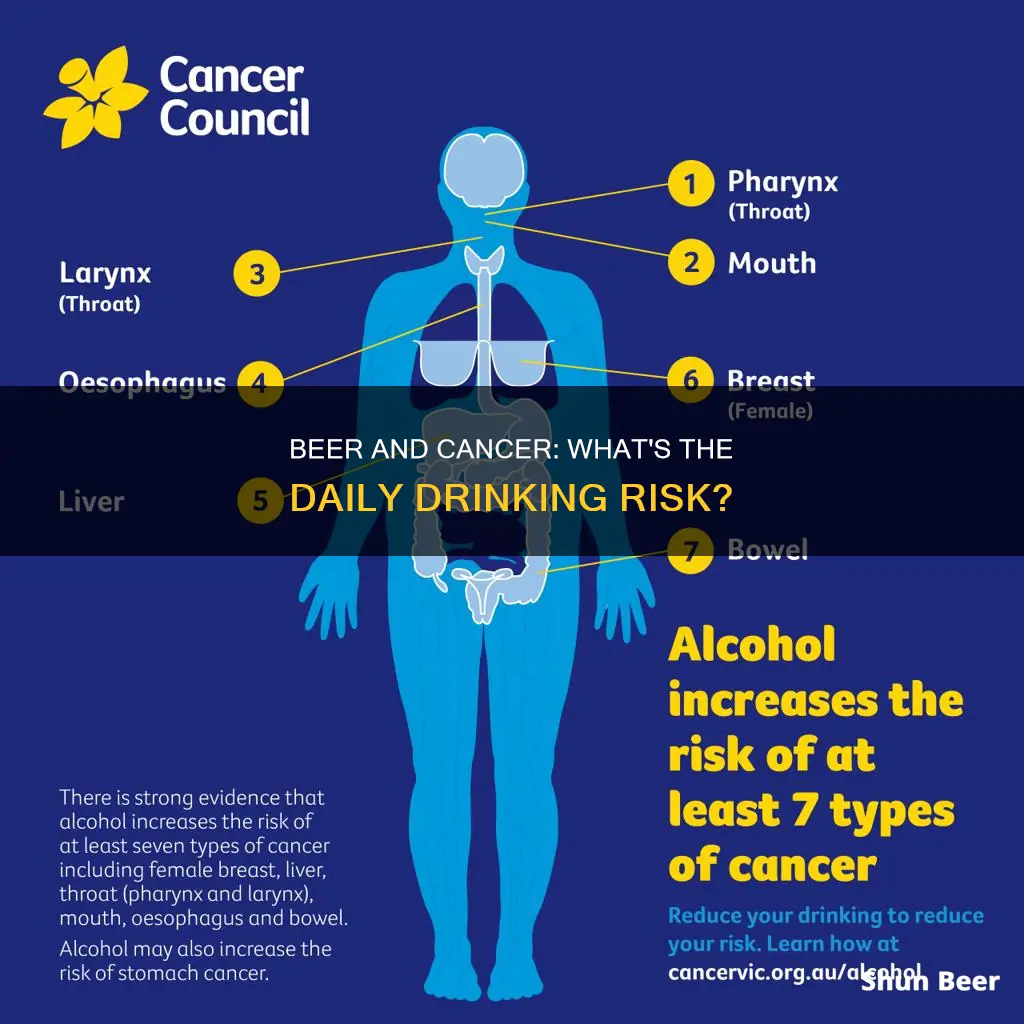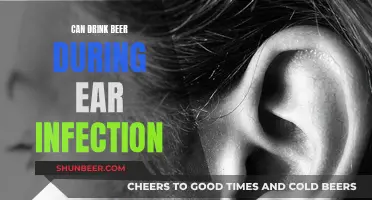
Drinking alcohol is linked to an increased risk of several types of cancer. Alcohol is a Group 1 carcinogen, which is the same category as tobacco and solar radiation. Research has shown that alcohol consumption is associated with a higher risk of developing seven different types of cancer, including breast cancer, bowel cancer, and oesophageal cancer. The risk of developing cancer increases with the amount of alcohol consumed, and even moderate drinking can lead to a small increase in overall cancer risk. According to the National Institute on Alcohol Abuse and Alcoholism, a standard alcoholic drink in the United States contains 14 grams of pure alcohol, which is typically found in 12 fluid ounces of beer. While the type of alcohol does not matter, the more a person drinks, the higher their risk of cancer becomes.
| Characteristics | Values |
|---|---|
| Cancer risk | Drinking beer every day increases the risk of developing cancer. |
| Cancer types | Alcohol is linked to an increased risk of several types of cancer, including breast, bowel, throat, oesophageal, larynx, liver, colon, rectal, and oral cancer. |
| Cancer recurrence | Alcohol intake by cancer survivors has been associated with an increased risk of cancer recurrence, specifically for breast cancer survivors who drank more than three to four drinks per week. |
| Mechanisms | Alcohol is converted into acetaldehyde, a toxic substance and known carcinogen, during metabolism. Acetaldehyde damages DNA and proteins, increases oxidative stress, impairs nutrient absorption, and elevates estrogen levels, contributing to cancer development. |
| Guidelines | Official guidelines recommend not starting drinking for non-drinkers. For those who drink, moderation is advised: no more than one drink per day for women and two drinks per day for men. |
| Calories | Alcohol contributes to weight gain through excess calorie intake, and excess weight is linked to an increased risk of various cancer types. |
What You'll Learn

Alcohol is a Group 1 carcinogen
Alcoholic beverages have been classified as a Group 1 carcinogen by the International Agency for Research on Cancer (IARC), which is a specialist agency of the World Health Organization. This classification, given in 1988 and reaffirmed in 2009, means that there is sufficient evidence to support the carcinogenicity of alcoholic beverages in humans.
The IARC's evaluation states:
> There is sufficient evidence for the carcinogenicity of alcoholic beverages in humans. [...] Alcoholic beverages are carcinogenic to humans (Group 1).
This classification is based on epidemiological studies, which showed that cancer risk was independent of the type of alcohol, and animal studies, which demonstrated increased cancer risk with exposure to ethanol alone. Ethanol is a chemical substance found in alcoholic drinks such as beer, wine, and spirits (liquor).
The National Toxicology Program of the US Department of Health and Human Services also lists consumption of alcoholic beverages as a known human carcinogen in its Report on Carcinogens.
The mechanisms by which alcohol consumption causes cancer are not yet fully understood, but several plausible pathways have been proposed:
- Genotoxic effect of acetaldehyde: When the body breaks down ethanol, it produces acetaldehyde, a toxic and carcinogenic substance. Acetaldehyde can damage DNA and prevent cells from repairing this damage, allowing cancerous cells to grow.
- Increased estrogen concentration: Alcohol can increase estrogen levels, which is important for breast carcinogenesis.
- Solvent of tobacco carcinogens: Alcohol may act as a solvent for carcinogenic factors in tobacco smoke, enhancing its cancer-causing effects.
- Production of reactive oxygen species and nitrogen species: Alcohol metabolism can lead to the production of reactive oxygen species, which can damage DNA, proteins, and lipids in the body.
- Changes in folate metabolism: Alcohol can impair the body's ability to absorb and utilize folate, a nutrient that plays a role in DNA synthesis and repair.
It is important to note that the risk of alcohol-related cancers increases with the amount of alcohol consumed. Even light to moderate drinking can increase the risk of certain cancers, and there is no known safe threshold for alcohol consumption when it comes to cancer risk. Therefore, it is recommended that individuals who do not drink alcohol should not start, and those who do drink should limit their consumption to reduce their cancer risk.
Beer and Diabetes: Is Corona Beer Safe for Diabetics?
You may want to see also

Alcohol increases oestrogen levels
Alcohol consumption has been linked to an increased risk of several types of cancer, including breast cancer. According to the World Health Organization and the International Agency for Research on Cancer, alcohol is a Group 1 carcinogen, which is the same ranking given to tobacco. While this does not mean that drinking alcohol is as harmful as smoking, it does indicate a strong level of evidence that exposure to alcohol can cause cancer.
One of the ways in which alcohol contributes to cancer risk is by altering hormone levels in the body. Alcohol can increase the levels of certain hormones, such as oestrogen and insulin, which act as chemical messengers. Higher levels of oestrogen can lead to more frequent cell division, increasing the chances of cancer developing. This is particularly relevant for breast cancer, as oestrogen has a significant impact on breast cells.
The effect of alcohol on oestrogen levels is twofold. Firstly, alcohol can promote the induction of aromatases, which are enzymes that convert androgens (male sex hormones) into oestrogens. Secondly, alcohol can impair the metabolism of oestrogen in the liver, resulting in a buildup of oestrogen in the circulation. This elevated oestrogen level can then trigger oestrogen-sensitive cells to become cancerous.
The link between alcohol consumption and increased oestrogen levels has been observed in both premenopausal and postmenopausal women. In premenopausal women, alcohol may affect the pituitary-ovarian axis, leading to disruptions in normal hormonal cycling. In postmenopausal women, alcohol can increase oestrogen levels, which may have some beneficial effects on cardiovascular health, bone density, and immune function. However, it is important to note that high oestrogen levels, especially when combined with hormone replacement therapy, can increase the risk of breast cancer.
While moderate alcohol consumption may have some positive effects on oestrogen levels in postmenopausal women, heavy drinking can have detrimental effects on reproductive health. It can cause fertility issues, hormone deficiencies, lowered sex drive, irregular menstrual cycles, and even miscarriage. Additionally, heavy drinking increases the risk of various types of cancer, including breast cancer, as well as heart and liver disease, weight gain, and osteoporosis.
Overall, the impact of alcohol on oestrogen levels and cancer risk is complex and depends on various factors such as age, menopause status, and the amount of alcohol consumed. However, it is clear that excessive alcohol consumption can have negative consequences for health, including an increased risk of cancer.
Is Alcohol-Free Beer Halal?
You may want to see also

Alcohol affects men and women differently
Immediate Effects
Women generally experience the immediate effects of alcohol more quickly and intensely than men. This is because women's bodies contain proportionally less water and more fat than men's bodies. Water dilutes alcohol, while fat retains it, resulting in women having higher blood alcohol levels than men, even when body weight is taken into account. This means that one drink for a woman is roughly equivalent to two drinks for a man. Women also have lower levels of alcohol dehydrogenase, an enzyme that breaks down alcohol before it reaches the bloodstream. As a result, women can reach dangerous levels of alcohol in their blood while drinking on an empty stomach, increasing their risk of death while driving.
Long-Term Health Effects
Women who drink are more likely than men to develop liver disease, alcohol-related brain changes, heart disease, and strokes. Additionally, female alcoholics have death rates 50 to 100% higher than male alcoholics, including deaths from alcohol-related accidents, heart disease, stroke, and cirrhosis.
Cancer Risks
Drinking alcohol is linked to an increased risk of several cancers, including breast cancer, which is the most common cancer in the UK. Alcohol is a Group 1 carcinogen, and it increases the risk of cancer even in small amounts. The risk of developing breast cancer increases with the amount of alcohol consumed, and it is one of the biggest risk factors for this type of cancer. Moderate drinking, defined as one standard drink per day for women and up to two standard drinks per day for men, is associated with a small increased risk of overall cancer.
Other Risks
Women who drink are also at a higher risk of weight gain, which is linked to over 12 types of cancer. Alcohol contributes to weight gain by providing excess calories. Additionally, alcohol may cause changes in the cells of the mouth and throat, making it easier for them to absorb harmful chemicals that increase the risk of oral and throat cancers.
Beer and Cholesterol: Drinking Before a Test
You may want to see also

Alcohol may cause changes to cells in the mouth and throat
Alcohol is a Group 1 carcinogen, which is the same category as tobacco and asbestos. It is a leading cause of cancer and, according to the World Health Organization and the International Agency for Research on Cancer, there is a strong level of evidence that exposure to alcohol can cause cancer.
Alcohol can cause changes to cells in the mouth and throat, making it easier for them to absorb harmful chemicals that cause damage. When we drink alcohol, our bodies turn it into a chemical called acetaldehyde, which is highly toxic and damages the tissues in our mouths. This can lead to acid reflux, which can also damage cells and increase the risk of cancer of the oesophagus.
A British study found that approximately one-third of mouth and throat cancers were caused by drinking alcohol. Furthermore, when combined with smoking, alcohol may increase the risk of mouth cancer. Alcohol may also change how the toxic chemicals in tobacco smoke are broken down in the body, making them even more harmful.
Chronic alcohol consumption has been correlated with an increased risk of cancer and increased mortality, with the risk increasing with the amount of alcohol consumed.
Beer and Xarelto: Is It Safe to Drink?
You may want to see also

Alcohol increases the risk of tobacco-related cancers
Drinking alcohol is linked to an increased risk of developing several types of cancer. According to the National Institutes of Health (NIH), about 5.5% of all new cancer diagnoses and 5.8% of cancer-related deaths are attributed to alcohol consumption. While alcohol itself is a risk factor for cancer, combining it with tobacco use further increases the chances of developing certain types of cancer.
Oral Cancer
Alcohol consumption is a significant risk factor for oral cancer, and the risk increases with the amount of alcohol consumed. People who drink heavily and smoke have a much higher risk of oral cancer than those who abstain from both. The risk is particularly elevated for specific regions of the mouth and pharynx that come into direct contact with alcohol and tobacco.
Pharyngeal Cancer
Pharyngeal cancer, or cancer of the throat, is also associated with alcohol and tobacco use. The risk of developing this type of cancer increases with the level of alcohol consumption, and it is highest in the areas of the throat that are in closest contact with alcohol and tobacco smoke. The combination of alcohol and tobacco has a multiplicative effect on the risk of pharyngeal cancer.
Laryngeal Cancer
Laryngeal cancer, or cancer of the voice box, is another type of cancer influenced by alcohol and tobacco use. Even in non-smokers, drinking alcohol is directly linked to an increased risk of laryngeal cancer, with the risk increasing as alcohol consumption levels rise. The combination of alcohol and tobacco consumption has a multiplicative or even supra-multiplicative effect on the risk of developing this type of cancer.
Esophageal Cancer
While alcohol consumption and tobacco use are both risk factors for esophageal cancer, their effects appear to be independent of each other. However, when combined, alcohol and tobacco act synergistically to increase the risk of esophageal squamous cell carcinoma. The risk of this type of cancer is particularly elevated for heavy drinkers.
In summary, alcohol consumption is a significant risk factor for several types of cancer, including oral, pharyngeal, laryngeal, and esophageal cancers. Combining alcohol use with tobacco increases the risk of these cancers even further, and the risk generally rises with the amount of alcohol consumed. Therefore, reducing alcohol intake can lower the chances of developing these tobacco-related cancers.
Pregnancy and Non-Alcoholic Beer: Is It Safe?
You may want to see also
Frequently asked questions
Yes, drinking alcohol is linked to an increased risk of several cancers. According to the National Institutes of Health (NIH), about 5.5% of all new cancer diagnoses and 5.8% of all cancer deaths are attributed to drinking alcohol.
Drinking beer is linked to an increased risk of breast cancer, bowel cancer, throat cancer, oesophageal cancer, liver cancer, and colorectal cancer.
There are several ways in which drinking beer can increase your cancer risk:
- When the body breaks down ethanol, a chemical found in alcoholic beverages, it becomes acetaldehyde, a known carcinogen that damages DNA and stops cells from repairing this damage.
- Alcohol can affect the levels of hormones like estrogen, which tell our cells to grow and divide. The more cells divide, the higher the chances of something going wrong and cancer developing.
- Alcohol can make it harder for the body to absorb and use nutrients that protect it from cancer, such as vitamins A, B1, B6, C, D, E, K, and folate, iron, and selenium.
- Drinking alcohol is linked to weight gain, which is a risk factor for cancer.
- Drinking alcohol increases the risk of tobacco-related cancers, such as oral cancer and throat cancer.
According to health guidelines, it is recommended that men have no more than two drinks per day and women have no more than one drink per day. However, the best way to reduce your cancer risk is not to drink alcohol at all.
While some studies suggest that drinking wine may support heart health, there is no clear evidence that drinking alcohol has any health benefits. The potential benefits of drinking wine do not outweigh the cancer risk.







